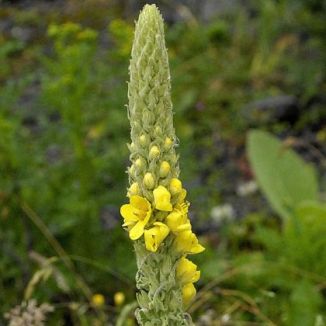The first year of this distinctive plant's life is spent growing its beautiful, velvety grey-green basal leaves, the second year the spike of yellow flowers rises up, sometimes to a height of 2 metres. Also known as Aaron's Rod, referring to the Old Testament story of the rod which broke out in golden blossoms, this plant flowers from June to August on roadsides throughout most of Ireland, west Donegal being the only part of Ireland in which it was not recorded at the time of the last Census of the Flora of Ireland in 1987. Each of the bright yellow flowers (15-30mm) comprises a corolla with a very short tube and five flat, spreading lobes. It is the leaves of this plant which give other names to this flower such as Flannel Flower and Woollen Blanket Herb. They are covered in thick soft hairs and cling to the winged stems along the spike, the basal leaves being ovate. This is a native plant belonging to the family Scrophulariaceae.
I first identified this plant in Castlecove, Co Kerry in 1978 and photographed it in Kinvara, Co Galway in 2005.
If you are satisfied you have correctly identified this plant, please submit your sighting to the National Biodiversity Data Centre




